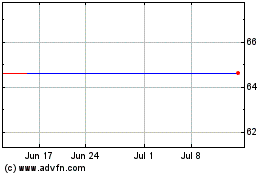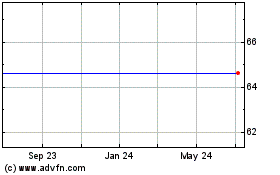Economists Question China's Consistent Growth Numbers
October 19 2016 - 9:20AM
Dow Jones News
BEIJING–Fresh doubts emerged over the reliability of Chinese
statistics on Wednesday after officials said the economy grew
6.7%—for the third consecutive quarter.
It was the first time since Beijing started releasing quarterly
figures in 1992 that it had achieved such a feat of
consistency.
Economists say it is rare for a fast-growing economy to clock
the same growth quarter after quarter. In China, it happens because
Beijing sets a hard economic target—6.5% to 7% this year—then does
what it takes to reach this level, whether through fiscal stimulus,
arm twisting of state companies or creative accounting, these
people say.
The International Monetary Fund and numerous economists have
urged Beijing to scrap that system, saying it leads to excessive
fiscal stimulus that fuels manufacturing overcapacity and debt.
"It's quite implausible that growth would be 6.7% for three
straight quarters," said Julian Evans-Pritchard, an economist with
Capital Economics Pte. "They're obviously smoothing the data quite
a bit" he said, adding: "Even by Chinese standards, this is a new
level of stability."
China's one-party state places a premium on stability, control
and gradualism, economists say. Higher growth targets also help
stem unemployment that could fuel social instability and threaten
party control, they add. China's official unemployment rate has
remained between 4% and 4.3% since 2002. Yet a paper from an
American nonprofit group, the National Bureau of Economic Research,
says the actual rate was an average of nearly 11% between 2002 and
2009.
Economists say Chinese growth data appears to be massaged by one
or two tenths of a percentage point–worth $10 billion to $20
billion in output. Any more would draw heightened global scrutiny,
they say.
"There always seems to be a tendency to round up rather than
down," said IHS Markit Ltd. economist Brian Jackson. "They tend to
use something like the "other services" category.
China's National Bureau of Statistics didn't immediately respond
to questions. But in the past it has said that its methodology is
sound and in keeping with accepted global standards.
In past periods of double-digit growth, Beijing often appeared
to go the other way, understating growth and inflation numbers,
economists say. A study this year by economists Emi Nakamura, Jó n
Steinsson, and Miao Liu in the American Economic Journal concluded
that China underreported growth by several percentage points a year
in the late 1990s, then overestimated growth and inflation after
2002. "Chinese official statistics are 'too smooth,'" it said,
which it said may be the result of political sensitivities as well
as poor data gathering methods.
"Concerns about inflation are one factor often cited as
contributing to the discontent that lead to the 1989 Tiananmen
Square protests," it said. "The remarkable stability of growth and
inflation statistics over the past two decades has undoubtedly been
an important source of popular support for the Chinese Communist
Party."
China's statistics have also come under question at home. When
Chinese Premier Li Keqiang was party secretary of northeastern
Liaoning province in 2007 he was quoted in a leaked U.S. cable
decrying the accuracy of what he called "man-made" statistics,
adding that he relied on measures presumably more difficult to
manipulate, including electricity output and freight traffic.
Since then, numerous banks have created their own version of a
"Li Keqiang index" inspired by his apparent skepticism.
China has made periodic efforts to improve—or at least
defend—the veracity of its growth numbers. Earlier this month,
President Xi Jinping stressed the importance of preventing fake
government statistics, vowing at a central leading group on reform
to punish data cheaters, according to the official Xinhua News
Agency.
Late last year, local officials in northeastern Liaoning,
Heilongjiang and Jilin provinces admitted doctoring gross domestic
product statistics during an anticorruption probe, Xinhua said.
Officials have strong incentives to fudge growth statistics,
economists say. While Beijing has edged away from evaluating local
officials solely on growth statistics, the numbers remain an
important criterion for getting promoted. Double counting is
another factor when, for example, transactions across borders are
claimed by both provinces. National statisticians now collect their
own independent provincial data in a bid to improve the data's
accuracy. In 2015, China adopted an IMF standard aimed at
strengthening its data system.
The official 6.7% growth figure for the January through March
period, when growth seemed particularly weak, was the most
questionable of the three, many economists said.
Mr. Evans-Pritchard said growth in the third quarter may have
exceeded 6.7% while the first quarter was lower. "This allows China
to reverse some massaging they did earlier, bring their data closer
to reality," he said.
RHB Capital Bhd. economist Fan Zhang warned: "There could be
more intervention as growth slows. They've set a target of 6.5%
from now until 2020 and need to make that target."
Write to Mark Magnier at mark.magnier@wsj.com
(END) Dow Jones Newswires
October 19, 2016 09:05 ET (13:05 GMT)
Copyright (c) 2016 Dow Jones & Company, Inc.
IHS Markit Ltd. (NASDAQ:INFO)
Historical Stock Chart
From Mar 2024 to Apr 2024

IHS Markit Ltd. (NASDAQ:INFO)
Historical Stock Chart
From Apr 2023 to Apr 2024
